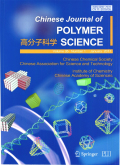- 钛学术文献服务平台 \
- 学术期刊 \
- 基础科学期刊 \
- 化学期刊 \
- 高分子科学(英文版)期刊 \
Self-healing Hydrogels and Underlying Reversible Intermolecular Interactions
Self-healing Hydrogels and Underlying Reversible Intermolecular Interactions
基本信息来源于合作网站,原文需代理用户跳转至来源网站获取
摘要:
Self-healing hydrogels have attracted growing attention over the past decade due to their biomimetic structure,biocompatibility,as well as enhanced lifespan and reliability,thereby have been widely used in various biomedical,electrical and environmental engineering applications.This feature article has reviewed our recent progress in self-healing hydrogels derived from mussel-inspired interactions,multiple hydrogen-bonding functional groups such as 2-ureido-4[1H]-pyrimidinone (UPy),dynamic covalent bonds (e.g.,Schiff base reactions and boronic ester bonds).The underlying molecular basics of these interactions,hydrogel preparation principles,and corresponding performances and applications are introduced.The underlying reversible intermolecular interaction mechanisms in these hydrogels were investigated using nanomechanical techniques such as surface forces apparatus (SFA) and atomic force microscopy (AFM),providing fundamental insights into the self-healing mechanisms of the hydrogels.The remaining challenging issues and perspectives in this rapidly developing research area are also discussed.

推荐文章
Geochemical tracing and modeling of surface and deep water-rock interactions in elementary granitic
Weathering
Water pathways
U activity ratios
Sr isotope ratios
Anthropogenic gases (CFC,SF6)
CZO
Transwell和Wound healing在细胞迁移中的应用比较
Transwell
划痕
血管平滑肌细胞
血清饥饿
一种基于用户行为的Self集构造和演化方法
计算机免疫
演化计算
计算机安全
入侵检测
内容分析
关键词云
关键词热度
相关文献总数
(/次)
(/年)
文献信息
| 篇名 | Self-healing Hydrogels and Underlying Reversible Intermolecular Interactions | ||
| 来源期刊 | 高分子科学(英文版) | 学科 | |
| 关键词 | |||
| 年,卷(期) | 2021,(10) | 所属期刊栏目 | FEATURE ARTICLES |
| 研究方向 | 页码范围 | 1246-1261 | |
| 页数 | 16页 | 分类号 | |
| 字数 | 语种 | 英文 | |
| DOI | |||
五维指标
引文网络
引文网络
二级参考文献 (85)
共引文献 (1)
参考文献 (125)
节点文献
引证文献 (0)
同被引文献 (0)
二级引证文献 (0)
1969(1)
- 参考文献(1)
- 二级参考文献(0)
1973(1)
- 参考文献(1)
- 二级参考文献(0)
1976(1)
- 参考文献(1)
- 二级参考文献(0)
1980(1)
- 参考文献(1)
- 二级参考文献(0)
1981(1)
- 参考文献(1)
- 二级参考文献(0)
1983(1)
- 参考文献(1)
- 二级参考文献(0)
1987(1)
- 参考文献(1)
- 二级参考文献(0)
1989(2)
- 参考文献(2)
- 二级参考文献(0)
1991(2)
- 参考文献(2)
- 二级参考文献(0)
1992(1)
- 参考文献(1)
- 二级参考文献(0)
1995(2)
- 参考文献(1)
- 二级参考文献(1)
1997(1)
- 参考文献(1)
- 二级参考文献(0)
1998(1)
- 参考文献(1)
- 二级参考文献(0)
1999(3)
- 参考文献(2)
- 二级参考文献(1)
2000(1)
- 参考文献(0)
- 二级参考文献(1)
2001(2)
- 参考文献(2)
- 二级参考文献(0)
2002(2)
- 参考文献(2)
- 二级参考文献(0)
2003(2)
- 参考文献(0)
- 二级参考文献(2)
2004(2)
- 参考文献(2)
- 二级参考文献(0)
2005(2)
- 参考文献(1)
- 二级参考文献(1)
2006(2)
- 参考文献(2)
- 二级参考文献(0)
2007(4)
- 参考文献(3)
- 二级参考文献(1)
2008(2)
- 参考文献(1)
- 二级参考文献(1)
2010(7)
- 参考文献(4)
- 二级参考文献(3)
2011(10)
- 参考文献(8)
- 二级参考文献(2)
2012(14)
- 参考文献(8)
- 二级参考文献(6)
2013(13)
- 参考文献(4)
- 二级参考文献(9)
2014(13)
- 参考文献(3)
- 二级参考文献(10)
2015(24)
- 参考文献(13)
- 二级参考文献(11)
2016(20)
- 参考文献(9)
- 二级参考文献(11)
2017(20)
- 参考文献(12)
- 二级参考文献(8)
2018(23)
- 参考文献(15)
- 二级参考文献(8)
2019(20)
- 参考文献(11)
- 二级参考文献(9)
2020(8)
- 参考文献(8)
- 二级参考文献(0)
2021(0)
- 参考文献(0)
- 二级参考文献(0)
- 引证文献(0)
- 二级引证文献(0)
引文网络交叉学科
相关学者/机构
期刊影响力
高分子科学(英文版)
主办单位:
中国化学会
中国科学院化学研究所
出版周期:
月刊
ISSN:
0256-7679
CN:
11-2015/O6
开本:
16开
出版地:
北京市中关村一街2号化学所院内
邮发代号:
创刊时间:
1983
语种:
eng
出版文献量(篇)
2840
总下载数(次)
0
总被引数(次)
6178
期刊文献
相关文献
推荐文献
- 期刊分类
- 期刊(年)
- 期刊(期)
- 期刊推荐
力学
化学
地球物理学
地质学
基础科学综合
大学学报
天文学
天文学、地球科学
数学
气象学
海洋学
物理学
生物学
生物科学
自然地理学和测绘学
自然科学总论
自然科学理论与方法
资源科学
非线性科学与系统科学
高分子科学(英文版)2022
高分子科学(英文版)2021
高分子科学(英文版)2020
高分子科学(英文版)2019
高分子科学(英文版)2018
高分子科学(英文版)2017
高分子科学(英文版)2016
高分子科学(英文版)2015
高分子科学(英文版)2014
高分子科学(英文版)2013
高分子科学(英文版)2012
高分子科学(英文版)2011
高分子科学(英文版)2010
高分子科学(英文版)2009
高分子科学(英文版)2008
高分子科学(英文版)2007
高分子科学(英文版)2006
高分子科学(英文版)2005
高分子科学(英文版)2004
高分子科学(英文版)2003
高分子科学(英文版)2002
高分子科学(英文版)2001
高分子科学(英文版)2000
高分子科学(英文版)1999
高分子科学(英文版)1998
高分子科学(英文版)2021年第9期
高分子科学(英文版)2021年第8期
高分子科学(英文版)2021年第7期
高分子科学(英文版)2021年第6期
高分子科学(英文版)2021年第5期
高分子科学(英文版)2021年第4期
高分子科学(英文版)2021年第3期
高分子科学(英文版)2021年第2期
高分子科学(英文版)2021年第10期
高分子科学(英文版)2021年第1期

 免费查重
免费查重










